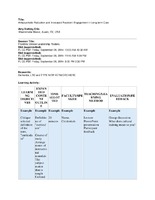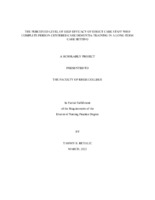| dc.contributor.author | Ellis, Amy Berkley | en |
| dc.date.accessioned | 2015-01-15T13:36:14Z | |
| dc.date.available | 2015-01-15T13:36:14Z | |
| dc.date.issued | 2015-01-15 | |
| dc.identifier | LEAD14PST82 | en |
| dc.identifier.uri | http://hdl.handle.net/10755/338360 | |
| dc.description | <p>Leadership Summit 2014 Theme: Personal. Professional. Global. Held at the Indianapolis Marriott Downtown, Indianapolis, Indiana, USA.</p> | en |
| dc.description.abstract | <p>Session presented on Friday, September 26, 2014:</p>
<p><strong>Purpose:</strong> Long-term care organizations are working to reduce the use of antipsychotic medications, particularly among residents with dementia. Non-pharmacological methods of managing behavioral and psychological symptoms of dementia (BPSD) include engaging cognitively impaired residents in enrichment activities. Nursing managers need to alter the work environment so that residents preferences and capabilities are communicated in a format that is accessible to staff, particularly non-native speakers of English and staff with lower levels of education.</p>
<p><strong>Significance and Background:</strong> Directors of Nursing at an Austin, TX, continuing care facility allocated an extra Certified Nursing Assistant (CNA) per shift to their memory care unit so that this floater could spend time arranging activities to stimulate the cognitively impaired residents. However, staff continued to focus on their care tasks, preferring to subdivide the residents care among themselves at a lower staff/resident ratio. In addition, PRN staff had little information about residents and were reluctant to initiate stimulating activities. realized that existing functional maintenance profiles, devised by speech and occupational therapists provided some psychosocial information about residents but were handwritten and frequently contained therapy-oriented acronyms and jargon, which was intimidating to many CNAs.</p>
<p><strong>Project Description:</strong> To make the residents capabilities, emotional triggers and preferences more accessible to the CNAs who cared for them, nursing managers created a graphical display from a large whiteboard divided into five color-coded sections based on residents' abilities. They hung the board in the staff break room and made magnetic name labels for each resident. Nurse managers and therapy staff combined Minimum Data Set (MDS) quarterly evaluation cognitive scores, admission assessment profiles and the FROMAJE Mental Status Evaluation used by the therapy department and categorized residents into one of five different color-coded groups based on these results. They also sought input from the Activities Director, who was very familiar with residents preferences and their comfort level in various groups and activities. Alongside each group (red, blue, yellow, orange and green) were symbols depicting activities suitable for people in that group, such as a jigsaw puzzle with the number 20 inside it (to depict an easier puzzle); a teddy bear for lower-functioning residents who enjoyed soft toys; a music note for singing and recordings; and so forth. Using symbols instead of paragraphs of text made it more visual and easier to understand, particularly for non-native English speakers, who made up 50% of CNAs.</p>
<p><strong>Conclusions and Implications for clinical practice:</strong> Information about residents must be presented in a user-friendly manner that CNAs with varying levels of education and reading ability can understand. By placing the chart in full view in the staff break room, by encouraging CNAs to share information about residents preferences and move them between different groups as their condition changes, staff feel more empowered to lead small groups in suitable activities and to share management techniques with other CNAs. Keeping residents engaged has the potential to improve their living experience, can reduce falls, and can redirect them from repetitive or distressing behaviors. In the memory unit it may also eventually enable the facility to reduce antipsychotic use, as recommended by Centers for Medicare and Medicaid Services (CMS).</p> | en |
| dc.format | Text-based Document | en |
| dc.language.iso | en_US | en |
| dc.subject | Dementia | en |
| dc.subject | LTC | en |
| dc.title | Antipsychotic reduction and increased resident engagement in long-term care | en_US |
| dc.type | Presentation | en |
| dc.rights.holder | <p>
All rights reserved by the author(s) and/or publisher(s) listed in this item record unless relinquished in whole or part by a rights notation or a Creative Commons License present in this item record.
</p><p>
All permission requests should be directed accordingly and not to the Sigma Repository.
</p><p>
All submitting authors or publishers have affirmed that when using material in their work where they do not own copyright, they have obtained permission of the copyright holder prior to submission and the rights holder has been acknowledged as necessary.
</p> | en |
| dc.description.note | <p>Items submitted to a conference/event were evaluated/peer-reviewed at the time of abstract submission to the event. No other peer-review was provided prior to submission to the Henderson Repository.</p> | |
| dc.type.category | Full-text | en |
| dc.evidence.level | N/A | en |
| dc.research.approach | N/A | en |
| dc.contributor.department | Epsilon Theta | en |
| dc.author.details | Amy Berkley Ellis, BA, MSN | en |
| dc.conference.name | Leadership Summit 2014 | en |
| dc.conference.host | Sigma Theta Tau International | en |
| dc.conference.location | Indianapolis, Indiana, USA | en |
| dc.date.conferenceyear | 2014 | |
| dc.contributor.affiliation | Westminster Manor, Austin, Texas, USA | en |
| dc.description.reviewtype | Abstract Review Only: Reviewed by Event Host | en |
| dc.description.acquisition | Proxy-submission | en |






